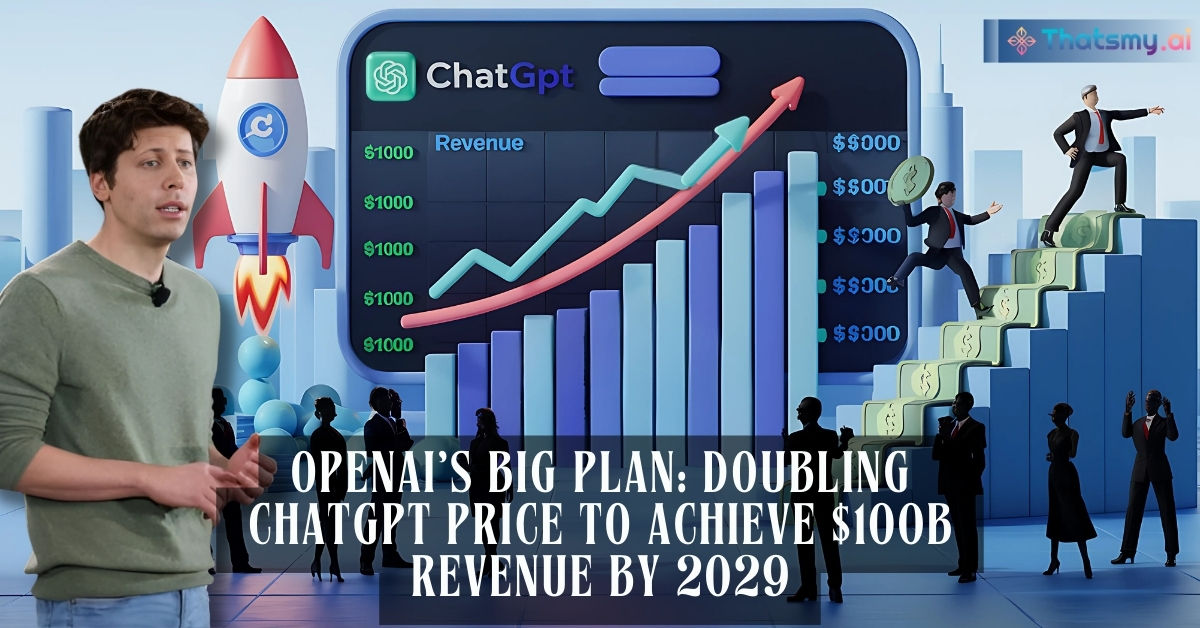OpenAI plans to double the price of its ChatGPT service over the next five years, aiming for $100 billion in revenue by 2029. Driven by rapid growth, ChatGPT's revenue is expected to surge to $2.7 billion this year, with significant contributions from businesses. OpenAI's biggest cost is the computing power provided by Microsoft, and major investments are planned to support their ambitious goals. They intend to introduce premium features to justify higher subscription prices while maintaining a growing user base.

OpenAI has ambitious plans to increase revenue by raising the price of its ChatGPT subscription service over the next five years. They aim to double the subscription cost and reach $100 billion in revenue by 2029. Currently, a ChatGPT subscription costs $20 a month, but OpenAI wants to increase that price to around $44 within five years.
They will also add more features to justify the higher cost. OpenAI's strategy is not just about raising prices; they want to make sure the service keeps improving and becomes even more valuable for users. By enhancing features, OpenAI believes people will see the extra value and be willing to pay more.
Free version of ChatGPT: Attracted many users.
Revenue growth: Grew three times since last year, reaching $300 million in August.
Future projections: Expected revenue for 2024 is $2.7 billion, with $1 billion coming from businesses.
ChatGPT has been a major driver of OpenAI's rapid growth, particularly the free version, which has attracted a lot of users. Many people started using ChatGPT because it was available for free, which has helped OpenAI grow very quickly. The company’s revenue has tripled since last year, reaching $300 million in August alone. Experts predict that ChatGPT could generate $2.7 billion this year—up from $700 million in 2023. About $1 billion of this revenue will come from businesses.
Businesses find ChatGPT helpful for customer support, answering questions, and automating parts of their workflow. This shows that the tool is useful not just for individuals but also for companies looking to improve efficiency.
OpenAI has significant operating costs, with the biggest expense being the computing power they receive from Microsoft. This partnership works like a cycle:
Microsoft gains: Microsoft benefits because OpenAI uses its cloud services.
OpenAI needs computing power: OpenAI needs Microsoft for all the computing power, which is costly.
This partnership is one of the reasons OpenAI has to keep raising its revenue to stay profitable. The cloud services provided by Microsoft are essential for making ChatGPT work. Without powerful computing, the AI wouldn't be able to handle all the questions and tasks users ask of it daily.
But using these services is very expensive, which is why OpenAI needs to increase its revenue to cover these costs while still making a profit. Microsoft, in turn, benefits because the more OpenAI grows, the more they use Microsoft’s cloud, which helps Microsoft's business grow as well.
Investments are also a significant part of OpenAI's growth strategy. Thrive Capital is leading an investment of over $1 billion in OpenAI, and Microsoft will invest another $1 billion, in addition to its existing $13 billion. These investments, along with raising subscription prices, are intended to help OpenAI achieve its major revenue goals.
The money from these investments will be used to improve ChatGPT and other OpenAI technologies, making them more powerful and efficient. This will help attract more users and businesses to the platform. Big investments like these show that other companies believe in OpenAI's future and its ability to grow and generate revenue.
Even with higher prices, OpenAI believes people will continue to use ChatGPT. Their plan isn’t to block access but to:
Add new premium features.
Offer better AI capabilities for paying customers.
The goal is to keep current users happy while giving them reasons to upgrade to a premium plan. OpenAI plans to offer new features that will only be available to subscribers. These might include more advanced AI tools, faster response times, or extra services especially useful for businesses.
By ensuring that paying users get extra benefits, OpenAI hopes to keep people interested even as prices go up. They want to make sure that everyone, whether using the free or paid version, finds value in ChatGPT.
User growth: ChatGPT's user base grew from 100 million in March to 350 million in June.
Developer engagement: Over one million developers are using OpenAI’s technology.
ChatGPT has experienced substantial growth recently, with the number of users growing from 100 million in March to 350 million by June. This growth is crucial to OpenAI's plans, as having more users helps generate more revenue and also provides valuable data to improve future AI models. Growth has come from both individual users and businesses, with over one million developers using OpenAI’s technology.
The more people use ChatGPT, the better OpenAI can make it because they can learn from how people interact with the AI. Developers are also building their own tools and services using OpenAI’s technology, which further spreads its use. This growth helps OpenAI build a strong foundation that will support its revenue goals and keep the company moving forward.
OpenAI is expanding quickly, even as other tech giants like Amazon attempt similar advancements in AI. OpenAI is confident that its unique partnerships and steady product improvements will help them stay a leader in AI technology. By working closely with companies like Microsoft and receiving large investments, OpenAI believes it can keep up with, and even surpass, the competition.
Amazon and other tech giants are also entering the AI market, which means competition will push everyone to keep innovating. However, OpenAI's advantage lies in the strong partnerships it has built and the continuous improvements it makes to its AI products. By focusing on making ChatGPT better and more useful, OpenAI hopes to maintain its lead in the expanding AI market.
As more people begin using AI, OpenAI is betting that they can:
Develop top-notch AI models that users will love.
Justify higher subscription rates by adding more value.
It’s still uncertain if OpenAI will reach their $100 billion revenue goal, but they have a clear plan for sustainable growth. They are focusing on making sure users feel like they are getting more than their money's worth. By adding better features, making the AI more helpful, and continuing to grow their partnerships, OpenAI aims to reach more people and convince them to subscribe.
Their growth plan is about more than just raising prices; it's also about adding enough value so that users feel comfortable paying more. If they can keep improving and keep their users happy, they believe they will be able to reach their ambitious revenue targets.
Sign up to gain AI-driven insights and tools that set you apart from the crowd. Become the leader you’re meant to be.
Start My AI Journey
ThatsMyAI
20 March 2025

ThatsMyAI
7 March 2025